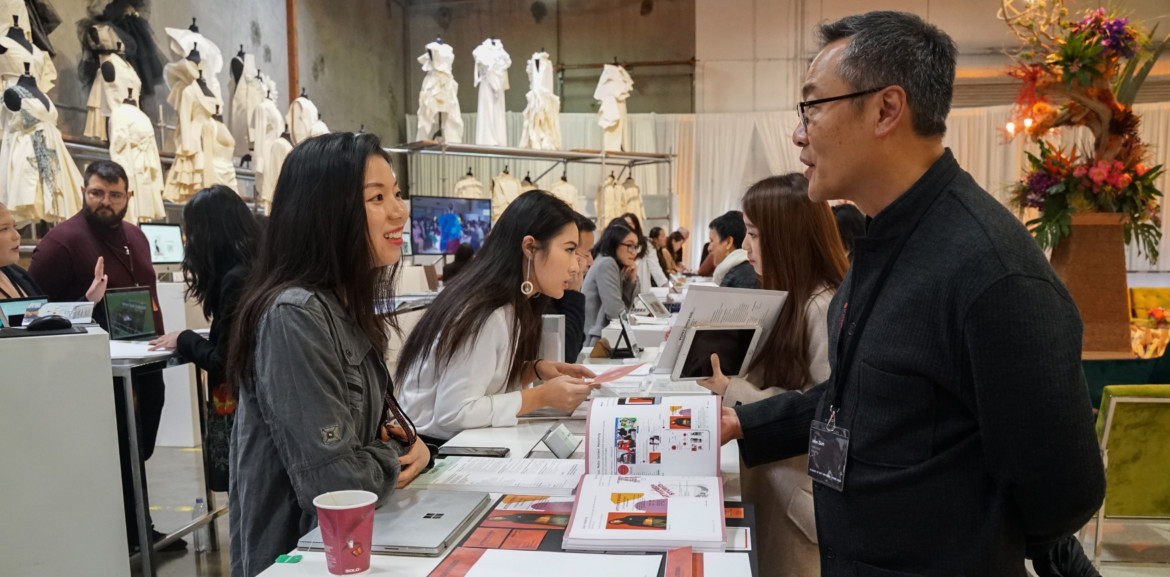Students met with industry guests and networked with alumni at this year’s Spring Show as they prepared to take the next step in their careers
By Kirsten Coachman
In recent years at the Academy of Art University, the third Thursday in May has become synonymous with being the biggest day of the academic year: Spring Show, the university’s premier showcase of top student work across its 22 departments.
Upon entering the venue at 2225 Jerrold that morning, guests were greeted by works from the graduating students from the School of Fashion, including the runway video of this year’s Graduation Fashion Show and Shop657’s pop-up shop, opposite live presentations from the School of Industrial Design’s corporate sponsored class, featuring collaborations with the Schools of Interior Architecture & Design, Web Design & New Media, Advertising, and Graphic Design.
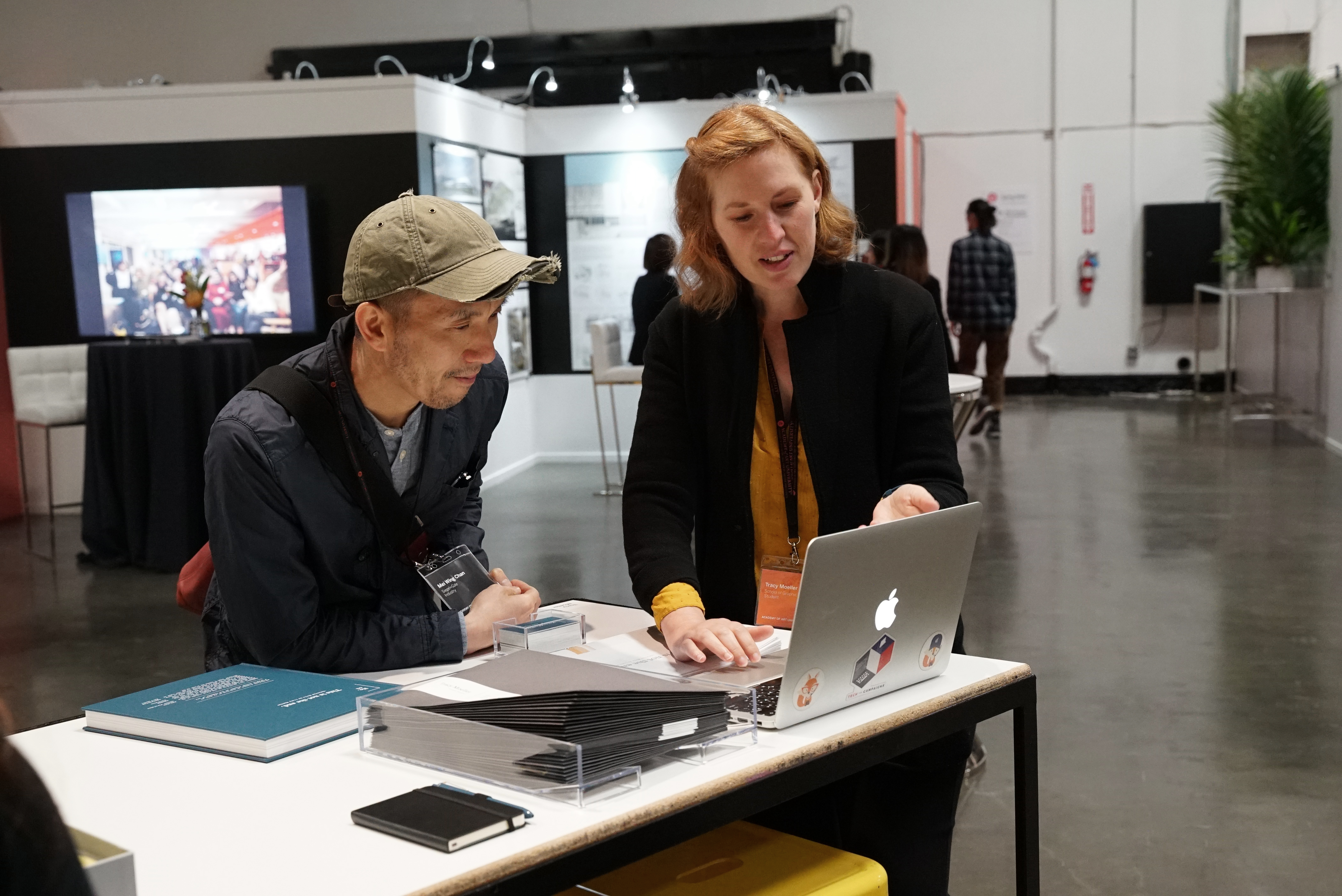
School of Graphic Design student Tracy Moeller shows off her website. Photo by Bob Toy.
Prior to opening this year’s Spring Show to the public that evening, the Academy welcomed a number of industry guests and alumni from top companies such as Walt Disney Studios, Marvel Animation, Apple, Gensler, Samsung, Netflix, Lucasfilm, LAIKA, iHeartRadio, Waterhouse Gallery, Williams-Sonoma, and Volkswagen Group of America, among others, to view the variety of works on display, as well as meet with students and review their portfolios.
Leading up to Spring Show, departments work closely with their students in preparing them not only for a day of networking, as they present their portfolios and projects to industry guests, but to instill a skill set that will benefit them long after they graduate from the Academy.
“What I like to tell people is that Spring Show is a place that expands the classroom environment,” said Executive Director of the School of Interior Architecture & Design Archana Myer. “It’s still a learning environment, but it’s this immense exposure to the industry, They have to talk to industry, they have to answer tough questions. … We tell them to be confident, to know their work is solid otherwise they wouldn’t be here, and to not take any conversation that is had here for granted.”
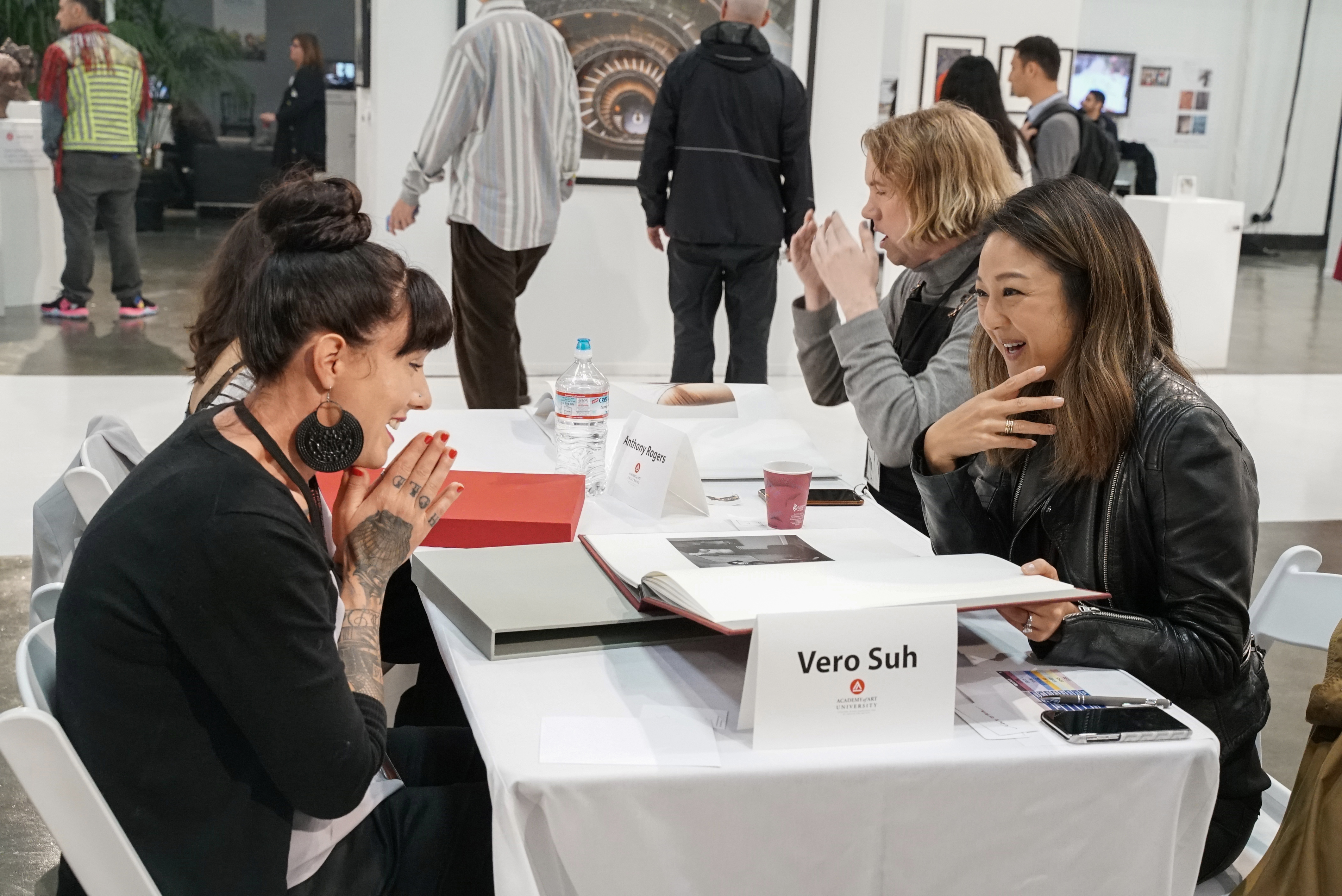
Photography student and Best in Show winner Rachelle Steele (left) speaks to industry guest Vero Suh. Photo by Bob Toy.
Preparing for all situations at Spring Show required students to put in the work ahead of time; from dressing appropriately to having professional takeaways, like business cards and résumés readily available, and doing research on the companies that would be in attendance. Executive Director of the Schools of Entertainment Jana Memel advised her students that would be meeting with film industry guests to not only be knowledgable about their professional credits but to have questions for them at the ready.
“Don’t make the people who are meeting with you have to think about what they’re going to ask you,” said Memel.
While the departments each have their own unique approach to Spring Show, those we spoke with expressed the same end goal for their students.
“[To] get jobs,” said Executive Director of Game Development David Goodwine. He acknowledged that while the day’s interviews may not result in an immediate hire, it’s the facetime with industry representatives that provides his students an edge in a competitive field. “If I can get as many of these students in front of as many companies as possible all in one spot, that is ideal.”
Department coverage by Cristina Schreil and Nina Tabios
School of Animation & Visual Effects
Two visitors to the School of Animation & Visual Effects (ANM) touched a screen and yelped. Summoning a student project on the touchscreen monitor that had been attracting people all day, they triggered a chaotic scene: herds of panicked dinosaurs exploded into extinction after a comet rammed into the earth.
This scene, created by student Yang Wu to demonstrate mastery of dynamics like explosions, smoke and fire, was one of many examples of student work on display.
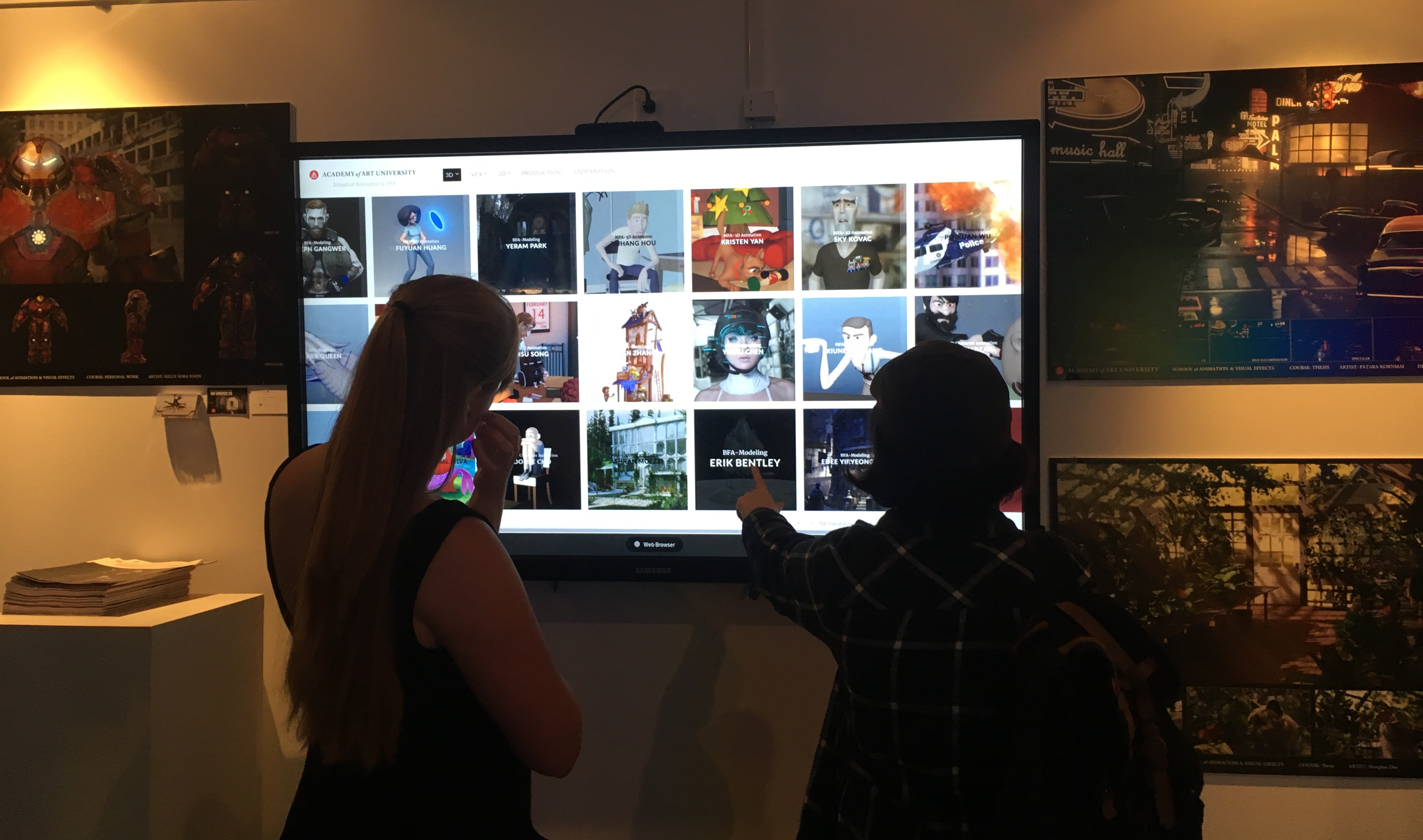
Two visitors interact with a touchscreen display at the front of the School of Animation & Visual Effects exhibition area. Photo by Cristina Schreil.
According to William Ziegler, ANM editing coordinator, it’s demonstrative of how things were a little different this year at ANM’s Spring Show exhibition. They made an effort, he said, to emphasize more video and web content, on display at several computers and television screens, over physical prints. That’s not to say screens dominated; there was still plenty of compelling art lining gallery walls and maquette displays at the exhibition’s heart.
Similar to past years, however, was the hustle and bustle of each zone, showcasing work by students studying 2-D animation, stop motion animation, 3-D animation and modeling, visual effects, and storyboarding. There was also a section presenting Studio X work. Also typical, the event drew many industry professionals. Ziegler pointed out a gaggle of students interviewing with a Marvel representative.
There was also a new space. “This year we have so many great storyboarding and animatic people that they got their own kind of bay here,” Ziegler said.
The storyboarding and 2-D animation work especially drew industry folks, including some from Netflix, according to Shaun Featherstone, freshman studies coordinator. He added that this year’s vibe felt different. “The impression I’m getting from the students is that the communication between them and the industry is actually much more direct, much more personable,” he said. He mused that this may be because of the good reputations of specialized departments. “It’s allowing the industry to be a lot more comfortable, going to the point people are saying, ‘Who have you got this year?’” Featherstone said. They’re “coming back like old friends,” eager to scoop new talent—and ANM students were ready.
School of Architecture
A new setup at the School of Architecture (ARH) not only solved past logistical issues, but emulated what architects do in a more engaging way.
“We changed the format this year,” explained Undergraduate Assistant Director Karen Seong. Tucked behind a wall separating a large exhibition of student work was a section shielded by Spring Show’s ambient din. There, bolstered by a new PA system, students gave thesis presentations. Industry guests offered feedback. “Having a dialogue in a group makes the discussions much richer,” Seong said. It’s also more comfortable: “This format is something that’s familiar to all architecture students.”
Seong highlighted a collaboration between ARH student Lamiae Ameziane and fashion student Gardenia Zhou. They created six pieces described as “architecture that can move.”
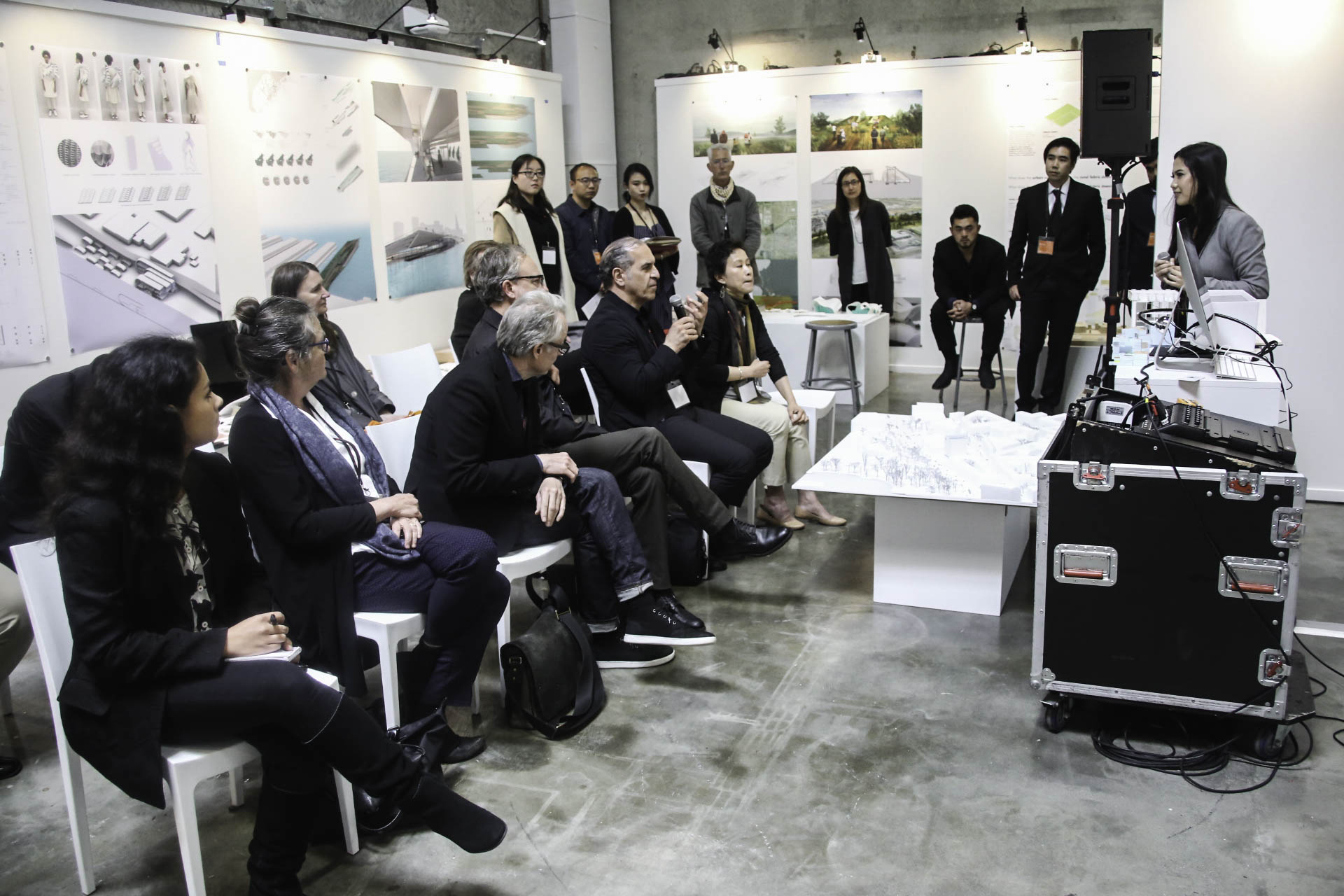
School of Architecture students presented their work to industry guests throughout the day at Spring Show. Photo by Adrian Childress.
In the afternoon, undergraduate faculty presented thesis awards, including ones for projects aimed at community recovery and regeneration and global climate change awareness.
A top award went to Ahmad Jabassini, who began his studies in Damascus, Syria in 2008. When war erupted in 2010, his family fled, settling in Los Angeles. He continued his education at the Academy. Jabassini’s project, “The Museum of Life,” derives from his harrowing experience. It’s built over land decimated by war and scarred by escape tunnels. His vision was a “public program and educational area that is designed to create public positive spaces that help people to recover from the war and sit with each other and communicate,” Jabassini said. He incorporates the tunnels, transfiguring them from fearful passageways—a method inspired by Japanese Kintsugi art, which uses gold to mend pottery. Jabassini “used the role of architecture to transfer a destroyed site into a space that can heal the people and society.”
ARH faculty awarded him the Best Thesis Director’s Award and The Henry Adams Honor Medal & Certification from the American Institute of Architects.
“There’s no doubt in our mind, what you’ve gone through, what you’ve done for us as a school, what you’ve done for the online program and what you’ve shown to us individually, as a person, that this is a very, very proud choice” said Undergraduate Director Jennifer Asselstine.
In accepting, Jabassini said, “I was an online student, but I’ve never been alone. I never felt disconnected.”
School of Art Education
As in past years, as Spring Show opening-day energy reached a fever pitch in other departments, the School of Art Education was more mellow.
On display, however, on a television screen and in photographs peppering the space, was evidence that students’ work—in mastering their dual pursuits of both art and pedagogy—was just as passionate.
Photographs captured students in action: teaching or leading projects at area elementary, middle and high schools, the Exploratorium, UCSF Medical Center and schools abroad. Video presentations anchored the display. Rather than a thesis book, students create short documentary-like Capstone videos that tell the story of the art education program they develop.
Assistant Director Matthew Sweeney, who manned the booth, said these students feel a unique calling to share what they love with the world. They’re tasked with creating programs that don’t exist otherwise. These videos are ideal vehicles for relaying their projects to potential employers, to find collaborators or secure funding.
“It’s something you have to be passionate about. None of our students are coming in blasé about the industry,” Sweeney said, adding that it’s an alternative to the artist’s struggle. “They’re not interested in everything that comes with having to claw your way to the top or make the right connections. They’d really rather create a lifestyle where they’re able to do what they love or create their own work in their free time and get the added enjoyment of continuing to improve their skills in their teaching.”
Sweeney added that with the Academy’s sizable population of international students, the program’s emphasis often offers something different. “Here the approach is more about creative problem solving and self-expression, more of a Western approach to the arts and arts education.” Many then spread this approach abroad after graduation.
School of Art History
For Spring Show, the School of Art History (AHS) presented the work of its thesis students. Undergraduates from the B.F.A. program conduct research to tackle an original argument or research question in a 15 to 20 page paper; Students in the M.A. program are required to do the same in 30 to 50 pages.
“In essence, it’s their calling card for a graduate program, a doctoral program, a teaching position and a job in a museum or gallery,” explained AHS Director Gabriela Sotomayor. From there, framed excerpts were hung next to the described art. “We decided for this year we’re going to do something like presenting the abstract so individuals could look at the works of art and see the abstracts and read them and understand what research was being done.”
The AHS exhibit offered a museum feel to Spring Show. The sampling of thesis statements covered historical artists’ individual trajectories, such as Brazilian artist Maria Martins and 15th century Italian painter Piero del Pollaiolo. Others focused on how the history impacted art culture and symbols, from 20th century Polish politics redefining the late Byzantine icon to Our Lady of Czestochowa as a national icon to Nazi visual culture appropriating ancient Greece.
Sotomayor said AHS is mostly an online program now but she makes it a priority to take pictures of the event to share with her students. Most of her graduates will be in town for commencement, so they’ll get a chance to see Spring Show then.
“It’s a big deal for them to achieve this,” she said. “They’re going on [with their careers and education] and they’ve been accepted into Cambridge, the Courtauld [Institute of Art] in London, they’re going on to do some really incredible things in incredible programs and it’s a nice tip of the cap to see their work on display here.”
School of Advertising
What do Burger King and being ghosted have in common? Or Heinz ketchup and Nasa? How about Adidas women athletes and Greek statues?
This was just some of the innovative and perhaps quirky ideas hanging around at the School of Advertising’s (ADV) Spring Show exhibit, situated right next to its partner department, the School of Web Design & New Media. Throughout the semester, ADV students are tasked to think of brand campaigns and initiatives for a range of companies, from corporate giants to nonprofits. And it wasn’t just relegated to print ads and commercials. Many of the campaigns worked in social media movements, desktop and mobile applications to support an overall story, message and advocacy.
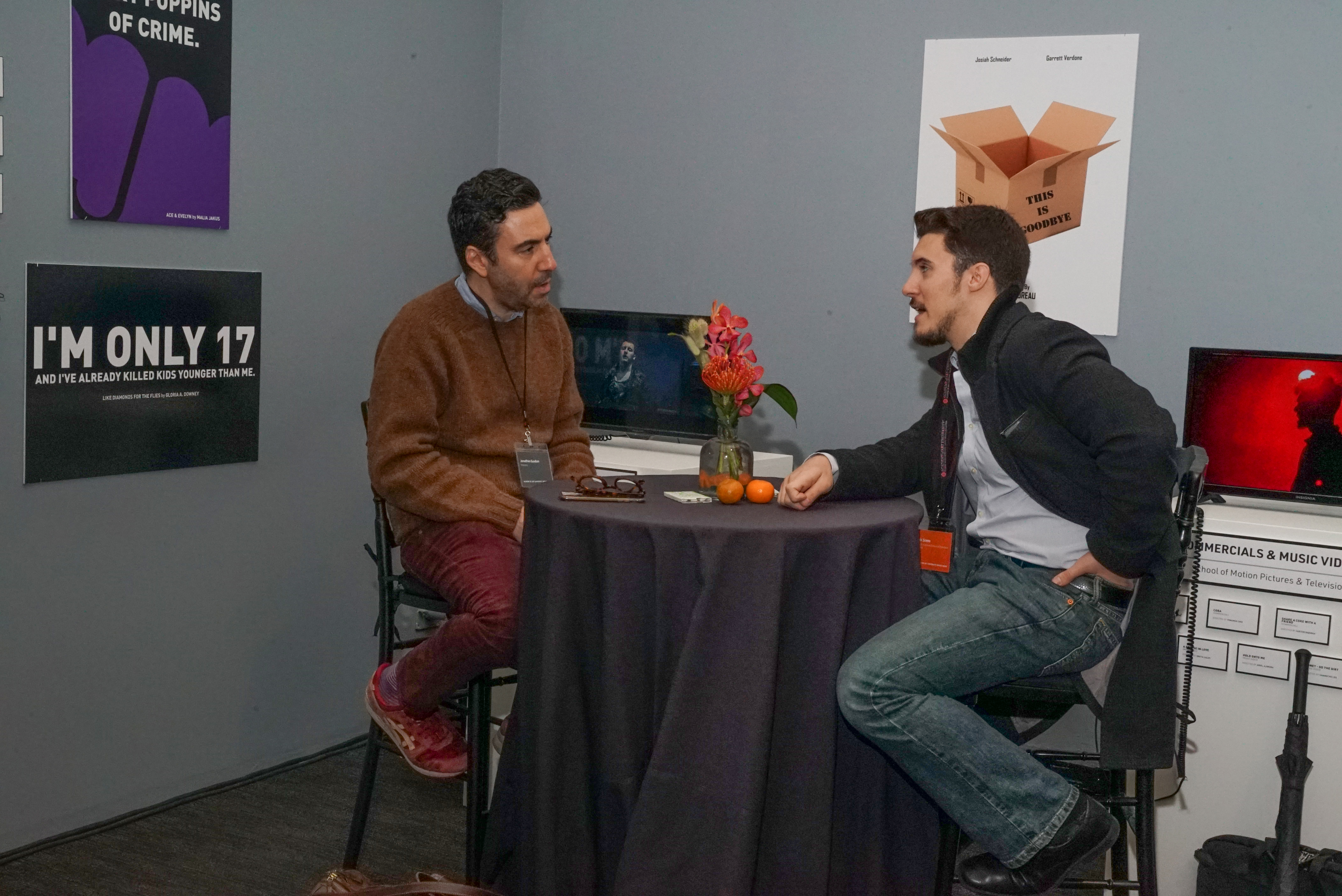
Several departments, including the School of Advertising, are where students got rare face-to-face time with working professionals in their industries. Photo by Bob Toy.
“Advertising isn’t just about trying to sell products to consumers,” explained ADV Co-Director Andrea Pimentel, “it’s about solving problems.”
Yash Ram, an M.A. copywriting student, had six projects on display, including his contribution to student-run ad agency Young & Hungry’s initiative to raise deep sea research funds for Blue Endeavors, an Alameda-based ocean conservation organization. His other projects included the Heinz and Nasa project, a Beats by Dre ad and a Proxima app concept that connects incarcerated mothers with their children.
He also presented an HP Studio Z campaign, which recently won gold in the 2019 Pencil Awards from The One Club for Creativity student competition. Even as he’s fielding phone calls and offers from companies, Ram is a bit sad to see his last Spring Show pass and felt it was important to show up and show out one last time with his classmates.
“I cancelled all my plans to come here,” he said. “We put in lots of hard work throughout the year and it’s such a good platform to showcase what we’ve done. People are coming in and seeing it, appreciating it, giving you feedback … hopefully, you can land a job. I think it’s a win-win situation for everyone, so why not come?”
School of Communications & Media Technologies
With their signature “Academy’s Got Talent” stage up and ready to go, School of Communications & Media Technologies (COM) Director Jan Yanehiro was ready to get the “speed-dating” underway.
No, they weren’t hosting the Academy’s version of “The Bachelor” or “90-Day Fiancé”—though live shows is something of a forte in COM. “Speed-dating,” Spring Show-style, is the round-robin interviews that put students face-to-face with industry professionals from corporate companies like CNET, ABC and Salesforce to independent production studios, like BP Productions and even local music distribution company, Empire Records.
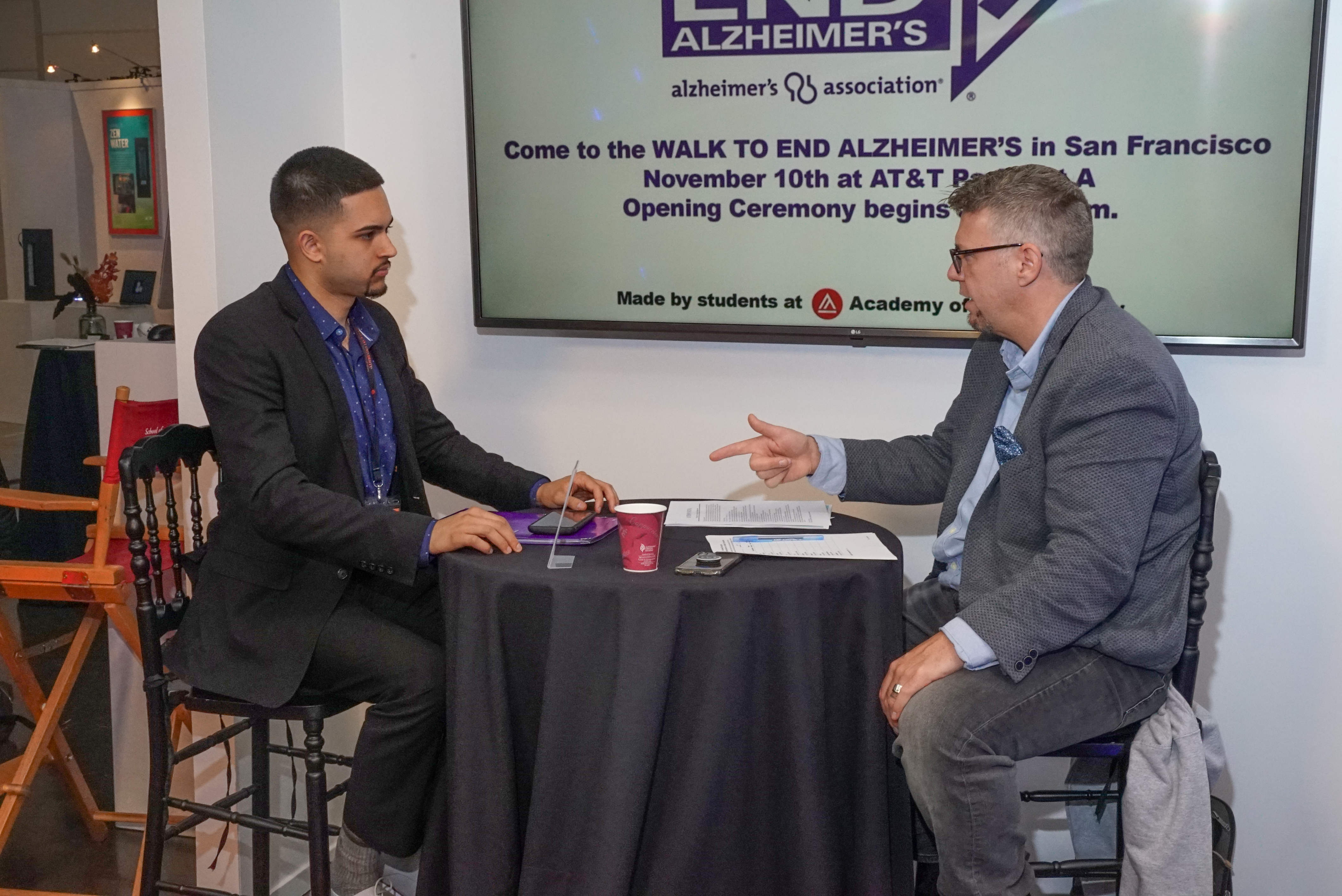
Several departments, including the School of Communications & Media Technologies, are where students got rare face-to-face time with working professionals in their industries. Photo by Bob Toy.
It’s an informal chat for the most part, per B.A. student Danny Black. With a few of his Academy esports-hosting days playing on the rotating reel, Black’s meetings involved going over portfolios but mostly talking about his goals and aspirations after school.
“A lot of these people and professionals have been in their industry for a really long time and I feel getting the input and experience from people who have been doing this was a really good step in knowing what comes next,” Black said. “Meeting them [here] in what feels kind of like a job fair, it’s an opportunity to really get your name out there and an opportunity to network. I’ve met people who are involved with things that I didn’t know were going on in my backyard.”
The real show didn’t start until the evening. COM students Maria Meza and Sheleia Brooks reprised their roles as former hosts of “Academy’s Got Talent” and the Annual Chinese Lunar New Year Parade to hype up the crowd for performances from former Urban Knights Radio Music Director Kenivah Bockari and last semester’s AGT winner, music production student Tanjanae Parker.
“I look forward to coming to this every year,” Black said of seeing his peers bring COM to life for Spring Show. “The production that went into this was fantastic, seeing all of the students’ work, seeing everything here kind of reminds me of why I wanted to come to Academy of Art in the first place.”
Schools of Entertainment: Acting, Motion Pictures & Television, and Writing for Film, Television, & Digital Media
Acoustic guitar music rang out in a comfortable sun-soaked living room. Then, a woman just footsteps away began to speak, locking eyes directly with the viewer. Suddenly the scene snapped to an urban rooftop. A quick look around—above, down at the ground and to any side—revealed the vertigo-inducing surroundings.
This was part of “Looking at Reality,” by B.F.A. student Taylor Kobryn, one of three virtual reality films visitors could watch—no, experience—at the Spring Show exhibition for the School of Motion Pictures & Television (MPT). Throughout the day, visitors strapped in and plunged into the worlds, moving and turning as they took in the 360-degree view.
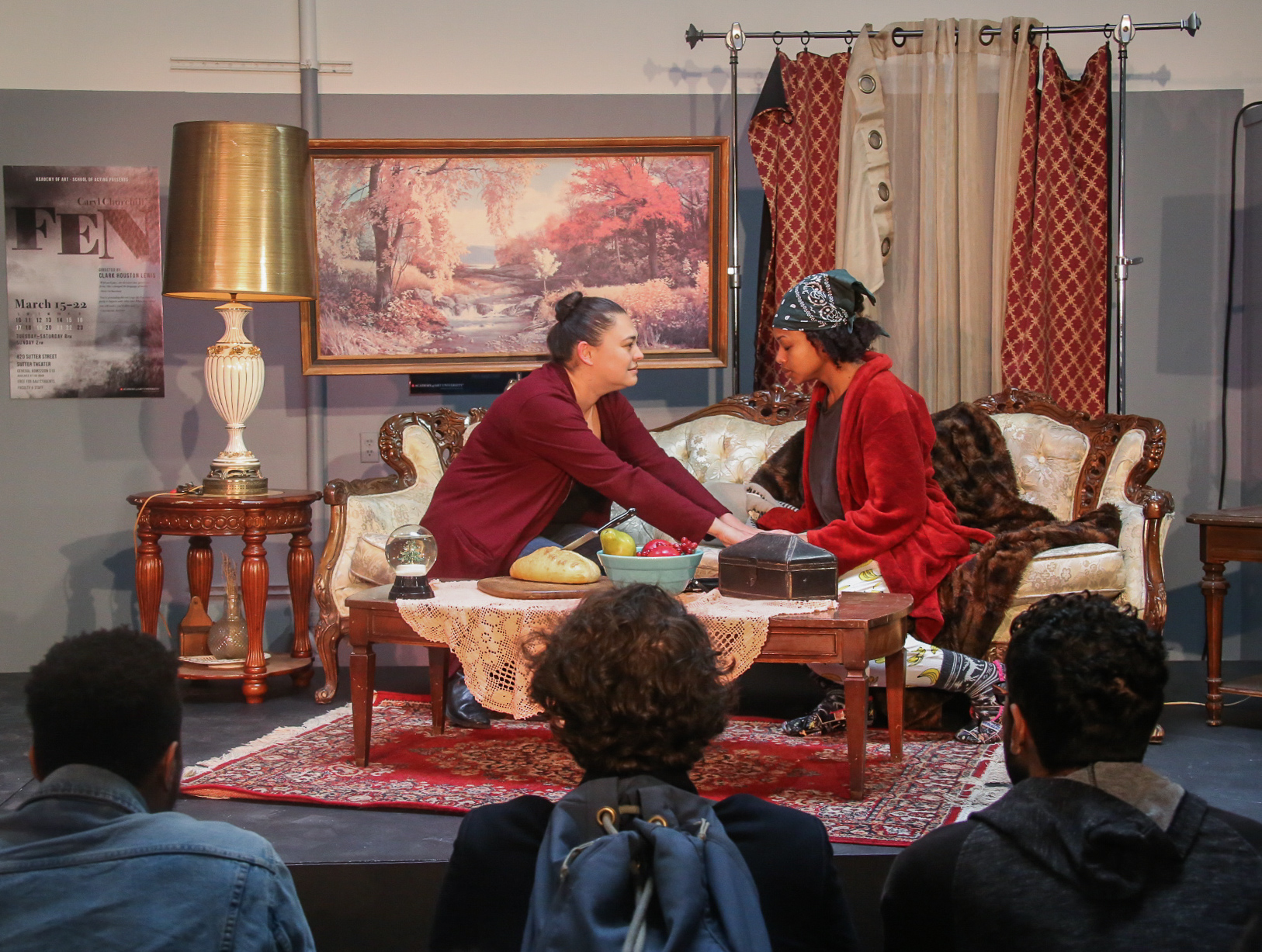
Renee Rogoff (left) and Shahd Elkier give a live performance at Spring Show. Photo by Adrian Childress.
The virtual reality station was hardly the only thing luring visitors to the MPT area, which shared a large space with and was adjacent to the Schools of Writing for Film, Television, & Digital Media (WRI) and Acting (ACT). Diverse storytelling was on display. Posters for student film projects decorated the walls, which also had large television monitors playing films—many of which were part of this year’s NXT Up Festival, taking place just weeks before. Stations with smaller monitors and equipped with headsets also lined the walls.
There was also room for students to meet with industry professionals, at tables and in a spacious couch area. It’s something that Jana Memel, executive director of the Schools of Entertainment (ACT, MPT, WRI), reinforced as a vital part of the schools’ Spring Show showcase each year.
“My overall approach is to have students meet with mentors we’ve brought from L.A. to give advice about how to go into the industry, which really is our goal here—to get our kids employed. I brought some really top-notch showrunners, Academy Award-winning producers, and I’m just introducing our best students to them,” said Memel.
Around the corner in a little nook, in the ACT exhibition, was a theater set up for live readings. An audience area contained posters from past productions, such as “In the Heights” and the musical “Legally Blonde.” Throughout the day, students performed original scenes by WRI students. Visitors were able to pop in and out. Renee Rogoff, one of the actors who participated, said she was focused, and barely noticed anyone watching. “If you don’t like being truly vulnerable in front of a crowd this might not be for you.”
School of Fashion
Fresh off the Graduation Fashion Show and portfolio review from the previous week, the School of Fashion (FSH) kept that same energy at Spring Show. They made sure to be sustainable too, rearranging last year’s steel scaffolding to couch senior collection muslins in a new arrangement above FSH’s featured students.
Hand-picked by Executive Director Simon Ungless, it was a strong showing of not just designers, but also merchandisers, marketers, stylists and journalists. When asked if being at Spring Show is different than the portfolio review or the static show, Nakia Pleasant said the key factor is being amongst the greater school population.
“It’s really cool to see everybody in the entire school because usually us in the fashion department, we’re just going to the Polk building and that’s it. We rarely get to meet people outside of our major so it’s nice to see all this hard work is going on,” said the graduating stylist.
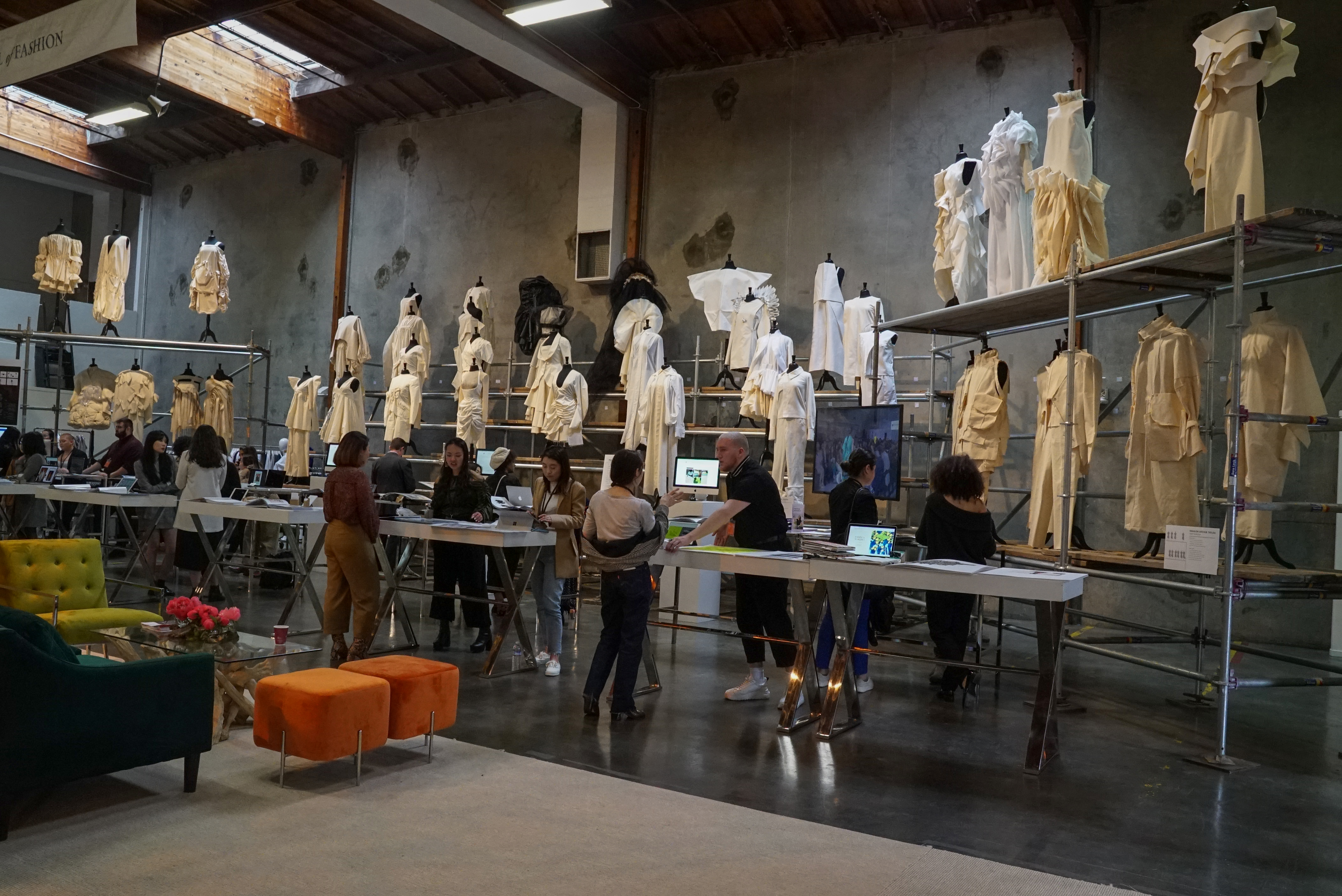
A look at the School of Fashion’s sustainable display at this year’s Spring Show. Photo by Bob Toy.
In that same vein, she was also able to meet industry professionals outside of just fashion. A representative from a record label, for example, swung by to check out her book. “Usually they don’t realize they need us until they see us,” Pleasant added. “The opportunity to talk with us and show them our work is nice.”
Tucked behind the steel scaffolding was the SHOP657 pop-up installation. A good example of what students on fashion’s business side do, the makeshift store carried Academy-specific hoodies, shirts and a few other student-designed pieces available for purchase.
One guest was eyeing a black short-sleeve graphic tee. It was between that or the white crew neck with multi-colored Academy logos across the chest.
“These are pretty cool,” she said with a wink. “I’m hoping this’ll inspire my granddaughter to maybe come here.”
School of Fine Art
Walk into Spring Show and the first sight to behold (after marveling at the School of Fashion’s steel scaffolding structure on the right) is the center hallway splitting the Jerrold warehouse.
Still life paintings and portraits made of oil and watercolor on canvas, coupled with demonstrative, if not sometimes striking, sculptures from the School of Fine Art (FA) instantly provided a distinguished gallery feel.
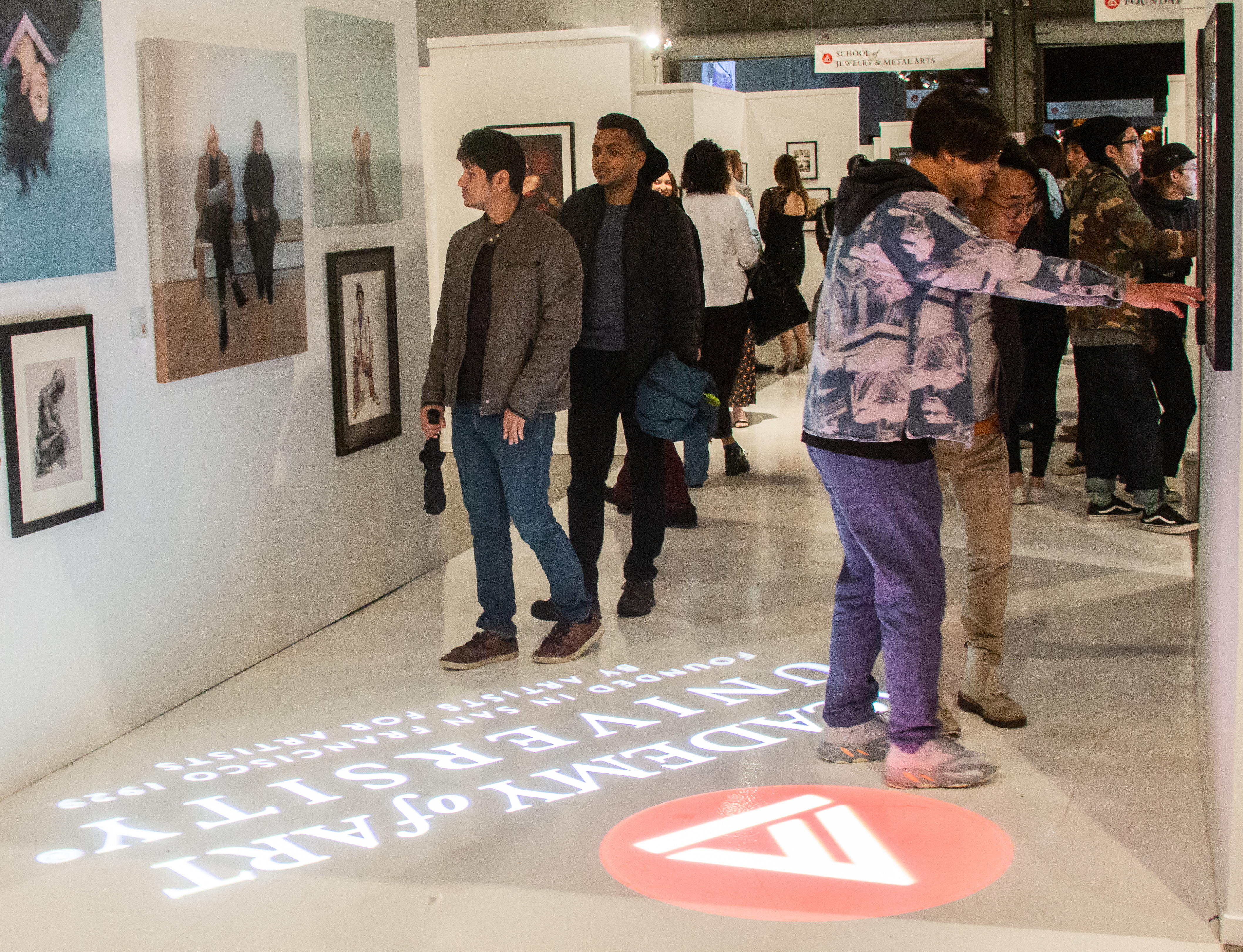
Guests viewed work from the School of Fine Art. Photo by Adrian Childress.
Turn any corner and you’d be met with a slew of life-like, emotive animal heads. On the other end was a cluster of eloquent charcoal drawings. The breadth of artwork shown was an example of the diverse styles, categories, genres and perspectives students delve into at the fine art department. Gabriel Islas from the B.F.A. program felt no shortage of pride to have his own paintings mounted next to his classmates’ and friends’ pieces.
“I’ve seen a lot of these paintings start from the beginning.,” Islas said, waiting for his turn to meet with a gallery member. To finally display art at Spring Show, to him, meant being among the best of the best. “It’s very validating. One of the walls here, pretty much every painting next to mine is a classmate. So I have history with them and I recognize not just the art itself but the style. So it’s almost like a little family up on the wall. It feels very nice to be put up against these artists I know through class.”
FA Executive Director of Painting & Printmaking Dr. Craig Nelson has seen his fair share of Spring Shows in his 30 years at the Academy.
“Every year we worry and every year it blows us away,” he said. “Every year a different category tends to float to the top, last year still life was the one but this year, figure work was just exceptional. This year, the figurative drawing just went way over the top.”
School of Game Development
If the School of Fine Art made Spring Show feel like an art gallery, then the School of Game Development (GAM) certainly made the Jerrold warehouse feel like an arcade. The slightly dim area was lit by the glow of student-made games on the four Academy kiosks and to the right of that area were neon lights outlining the play area for a new multiplayer VR puzzle game.
But to truly understand the scope of what GAM students learn at the Academy, you had to walk towards the back. Precise digital portraits, character designs, otherworldly environmental concept art and monitors exhibiting 3-D models are just a fragment of the work that goes into making games, each piece looking more professional than the last.
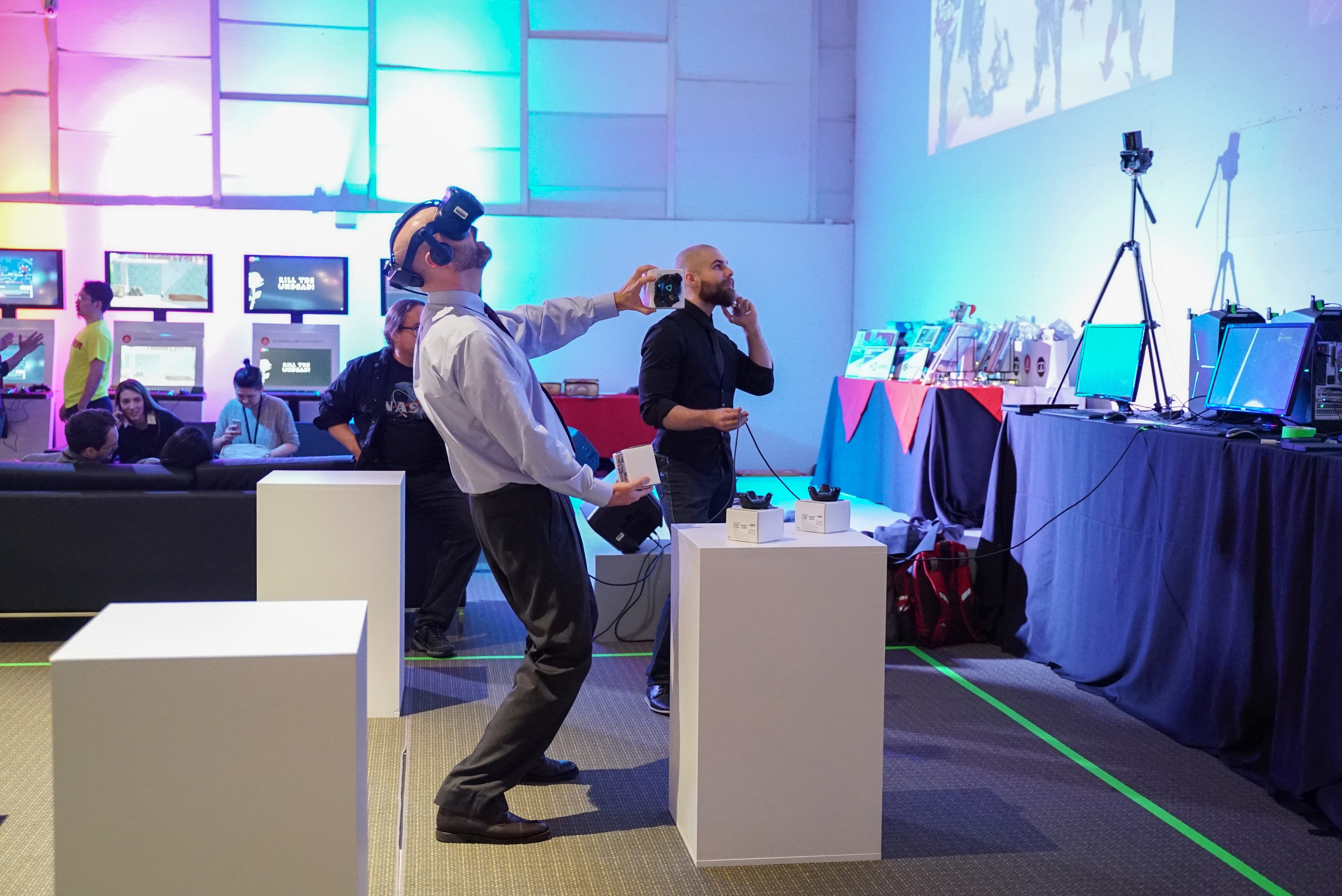
The School of Game Development’s newest Spring Show attraction was a multi-player VR puzzle game. Photo by Bob Toy.
Some students, like Shaie Nevilles, a concept art designer, are itching to dive headfirst into the industry. But being at Spring Show, at least for one last time, offers some validation that they’re ready.
“It’s just super cool. The atmosphere also makes me feel like I’m around a lot of other people who are trying to do the same thing I’m trying to do,” Nevilles said. “So it feels like a conductive artistic atmosphere.”
Early on in the day, Nevilles met with Dave Markowitz, a lead animator for Jam City, formerly of Disney Interactive. An Academy alumnus himself, Markowitz is a regular at the Academy’s Spring Show.
“I come up every year to look for new people and new talent,” he said. “It’s definitely about keeping the bar up there and that’s what I’ve seen in the past five years I’ve been coming. The game development program has really taken off and the quality of games, modeling, even the animation. I can see it’s really starting to kill.”
“The Spring Show has gotten so much bigger, it’s such a big event,” he added, laughing. “And I think it’s so important that they bring in the industry folks … I’ve seen Hyundai, Dreamworks; I was on the bus and I was like, ‘This was amazing!’ I was trying to get some networking in myself.”
School of Graphic Design
As enthusiastic crowds filtered into this year’s Spring Show exhibition, weaving in and out of each departments’ displays, School of Graphic Design (GR) student Tracy Moeller was envious. “I’m dying to look around,” said the soon-to-graduate B.F.A. student, who wouldn’t leave her post until 3:30 p.m.
Like her fellow presenting GR classmates, she manned her station, which contained her business cards, website and bound portfolio book showcasing a bevy of projects promoting products from an airline to a museum exhibition to smartphone apps. It was a format that mirrored GR’s Spring Show presence of the past—a tried-and-true presentation that links students to industry professionals.
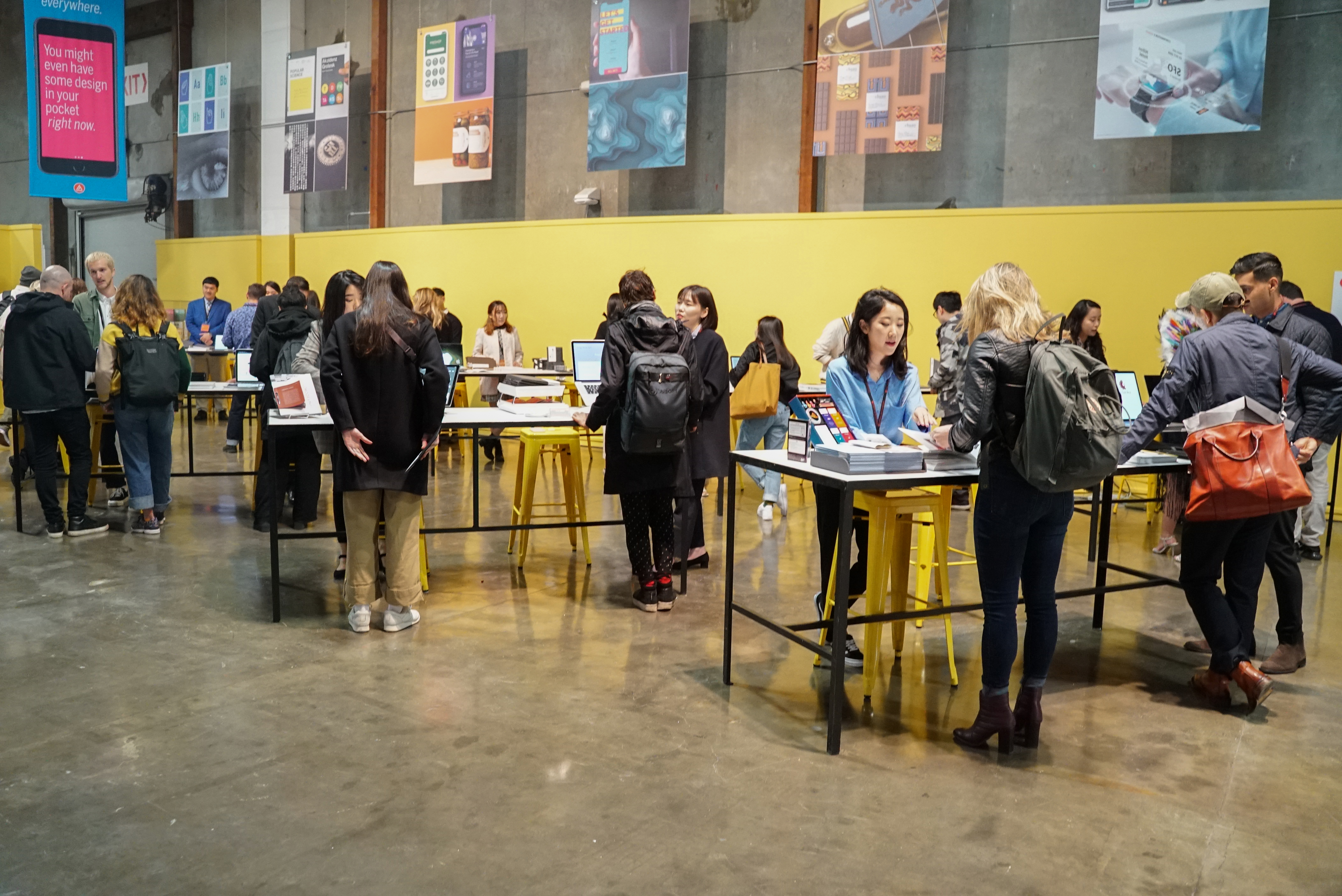
Graphic design students, manning stations equipped with their portfolios, speak to industry guests. Photo by Bob Toy.
The setup also fostered a “less pressurized situation” that Moeller was thankful for. “It’s a peek into what a job interview is going to be like … a practice,” she said. Creating her portfolio, she added, was also a helpful way to take in how her craft had evolved from start to finish. “It’s so much better,” she said with a laugh. “Half the work of this is controlling yourself and not redoing the project while you’re trying to put [the portfolio] together,” she reflected. “You see things in hindsight that you didn’t see then or didn’t even know about then.”
There was plenty of vibrant graphic art adorning the space: eye-catching posters displaying chic chocolate packaging to cases housing artfully labeled goods like liquors and olive oil. It seemed a trove of design inspiration.
To graduating B.F.A. student Silvia Laano, all artforms at Spring Show held potential—something an Academy instructor once urged. “Get inspired by lots of different sources. Get inspired by music. Get inspired by painting, textiles,” Laano recalled learning. “If you’re only drawing from your own field, that doesn’t bring necessarily something new to the table. And you get a lot of, ‘I’ve seen that trend.’”
Her classmates also offered lessons, from tips for optimizing workflow to shortcuts for digital tools. “That’s been huge,” she said.
School of Illustration
Situated in a wing occupying two other departments and steeped in cozier dimmed lighting, the School of Illustration (ILL) still buzzed with plenty of activity at this year’s Spring Show. As in past years, rows of gallery walls displayed students’ work, from enchanting children’s book scenes to transporting travel posters to movie advertisements and more.
ILL Director Chuck Pyle stood beside long tables where selected students met with industry professionals. He went down the line, pointing out those who’d secured jobs, illustration agents, scholarships, and awards. As students looked to the future, Pyle explained how they navigate today’s landscape of digital and print platforms.
“All the old markets are still there but if you can publish to apps and smartphones and have a bit of motion embedded in your artwork it makes you much more industry ready,” Pyle said. He added that this year presents “the same high quality.”
Dennis Dittrich from the Society of Illustrators enthusiastically agreed. “Every time we come out here, we’re always just blown away by what we see on the walls,” he said, gesturing to the “polish” around him. Dittrich emphasized the school’s strong foundations, noting how undergraduates are immersed in a uniquely comprehensive program. “They raise the bar every year, especially in the foundations. What they’re doing just to prepare people for the heavier lifting is what should be done everywhere and is not,” he said.
Around the corner, more students camped out with portfolios.
Katrina Rodriguez, a recent B.F.A. graduate, presented her comics. One centers on a father with a peculiar pizza head. She said she learned how to imbue her art with a clear point of view. “My experience here taught me to stay true to myself,” she said, “not necessarily to what will impress people.”
Beside her, Michael Baek, a B.F.A. student days away from graduation, offered his children’s books, including one about adoption. His style became less realistic but more harmonized to his own ideas over time. His work features “random patterns created by the watercolor and rough textures I can’t get from other mediums.” When asked how he felt, his answer fit Spring Show well: “half nervous, half excited.”
School of Industrial Design
It’s become a trademark of School of Industrial Design (IND) Director Antonio Borja to check up on his students with “How’s the future going?” At Spring Show, that future looked like autonomous cars, AI-driven robots, sleek, ergonomic motorcycles and statement-making footwear.
Many of these projects were conceptualized within three corporate sponsored classes IND offered this past semester. The Subaru-sponsored class prompted students to imagine Subaru as a vehicle and lifestyle brand for 2030. Another sponsor, Lightning Motorcycles was founded in 2006 but wanted to know what their Scrambler Segment bike could look like in 2020—to which students responded by building three life-size and super realistic, but untouchable, clay models. And for Red Falcon AI, student product designers dreamt of how the next generation of smart robots could look and function in our homes, supermarkets, museums and schools.
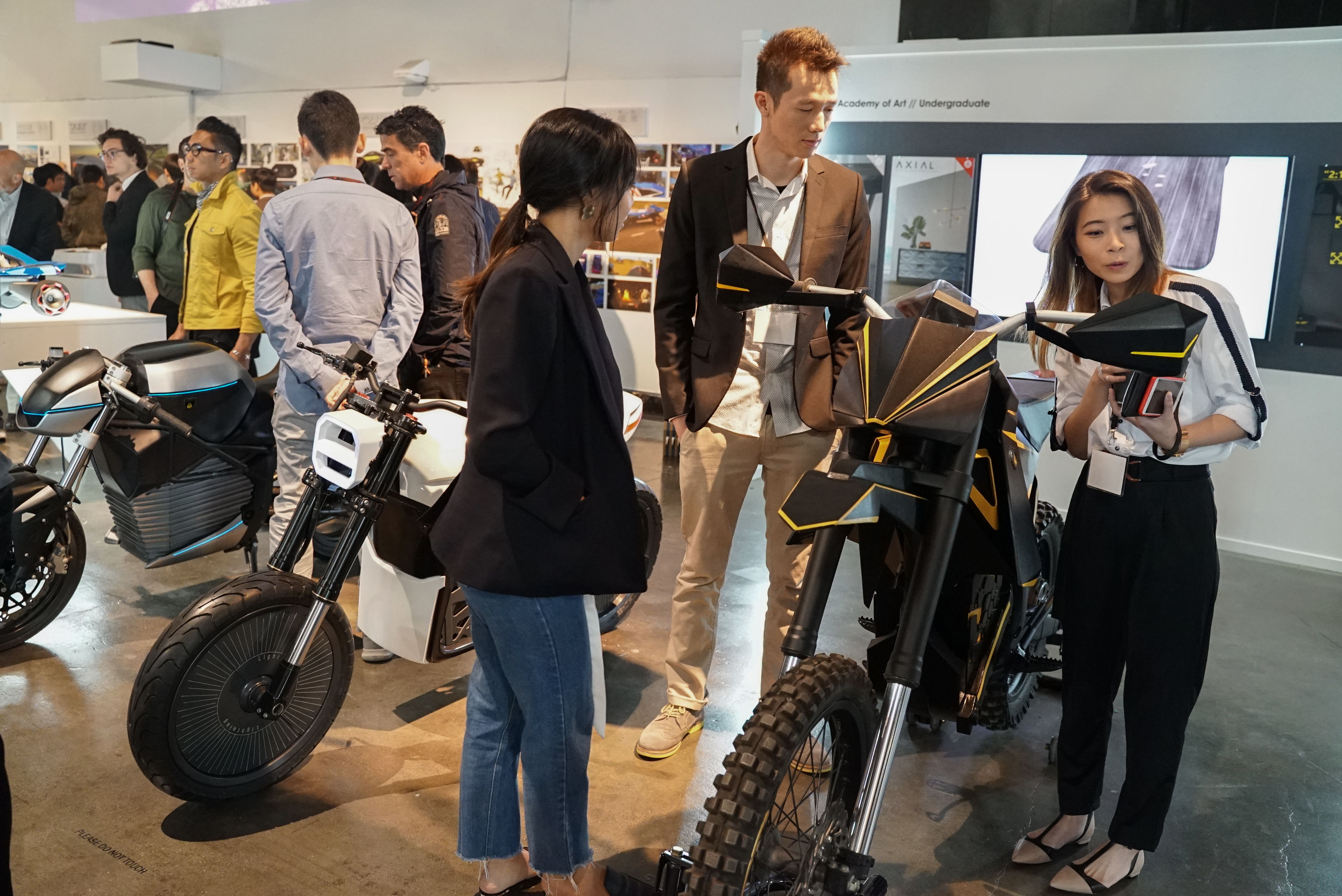
The life-like clay motorcycle models from the Lightning Motorcycles collaboration were a hit at Spring Show. Photo by Bob Toy.
IND Executive Director Tom Matano said participating in sponsored projects begets more sponsored projects. The 17-year Academy educator personally walked industry guests through the models and posters on display at Spring Show and emphasized, “It’s important that we let industry know what we are doing here.”
He sounds all business, but Matano also admitted that every Spring Show can be fun, if not a little sentimental, to see his former students return. It is here at the Jerrold warehouse where the school’s past meets with its present to hire for the future.
“For me it’s like a reunion. Today we had students from 10 to 12 years ago come back to check out [our students],” Matano said. “I remember in the beginning, getting a program up to speed was one [challenge], getting students into the industry was another. And now, these students that are coming back, these guys are at a senior level, middle management in their careers now and they’re here to hire or sponsor a project. It’s a complete, full circle. And it’s never ending.”
School of Interior Architecture & Design
As if slipping into a glistening wormhole, one visitor to the School of Interior Architecture & Design (IAD) stepped behind a wall and turned a wheel. It triggered vibrant movement across a screen displaying what felt like the inside of a kaleidoscope. The vision of Capstone Coordinator Tom Collum, it comprised bicycle wheels, plywood, mirror pieces and material samples. Students helped build it.
It was one way IAD’s setup—following the theme of “design factory”—flaunted their specialty: conjuring immersive interior environments.
As Executive Director Archana Myer described: “Our take on that is, ‘Can we create a space that evokes the senses and is engaging?’” She added it “represents elements that we create in spaces when we go out and design in the world.”
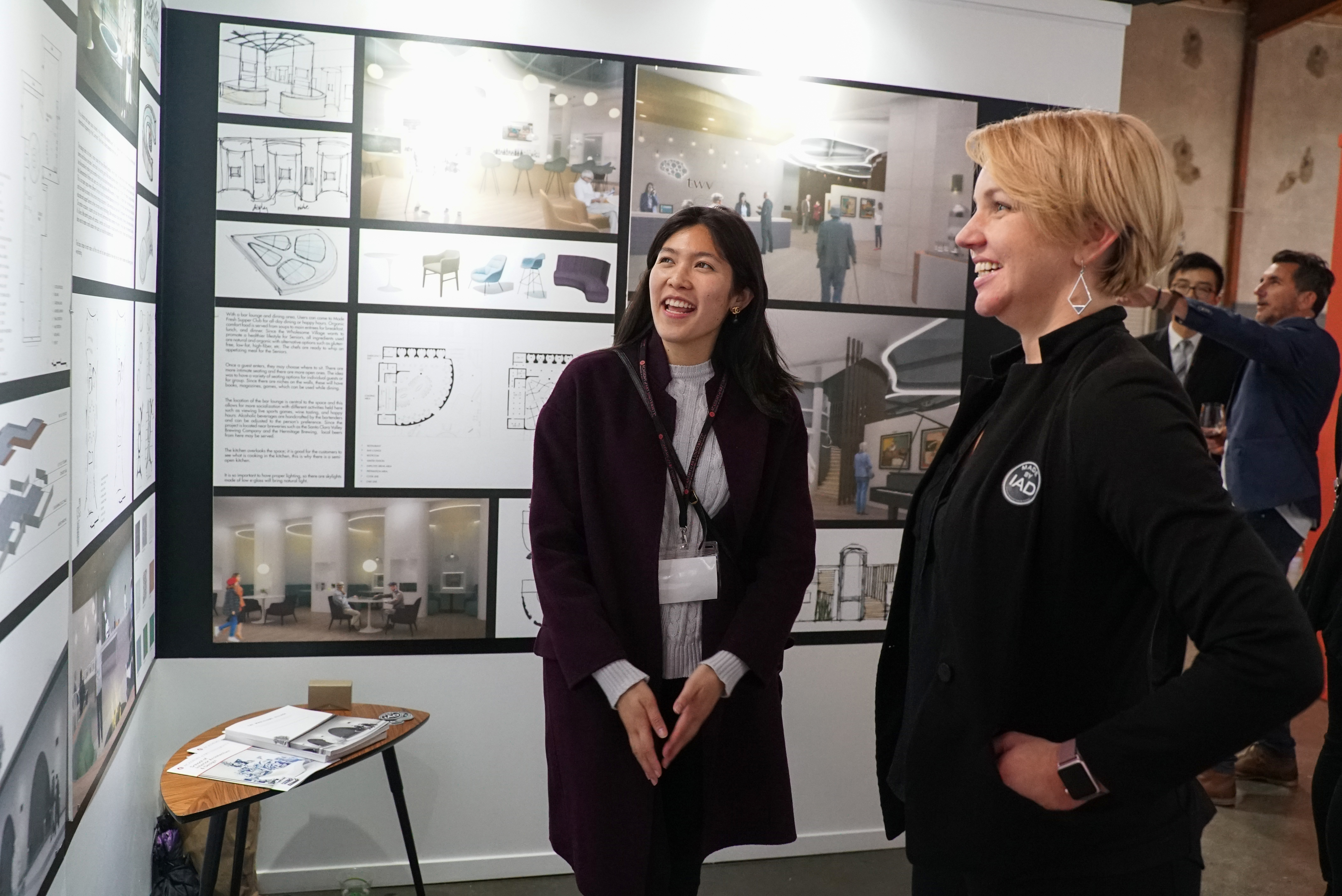
School of Interior Architecture & Design Director Katie Valkuchak (right) admires student work. Photo by Bob Toy.
Students also presented projects. Among them was graduating M.F.A. student Lauren Herrera, who designed an extended-stay hotel. Hand-rendered images showed her inspiration: Oakland’s automobile history. She shared that she loved learning to problem solve. “People don’t think about how important it is to have spaces that are designed well and that intuitively get you to go places or behave a certain way by the finishes that they choose and the layout that they design,” she said.
Nearby was second-year student Tao Ling’s downtown Oakland hotel design. He melded old and new: “Traditional structures, but my colors are really modern,” he said, gesturing toward pops of yellow.
Color was also strategic in a senior living facility design by B.F.A. student Yanchi Zhou. Comfortable living, via softer materials and easy-to-distinguish light furniture against dark floors, was priority. “For seniors, there are several problems,” Zhou said, adding that he dimmed colors to see through clients’ eyes. Zhou added a benefit of Spring Show besides industry connections: “Many friends or family members might not quite really understand what we’re doing,” he said.
IAD was also part of a large morning presentation for a 15-week Subaru-sponsored project. Five teams uniting students from IAD, the Schools of Industrial Design, Web Design & New Media, Graphic Design, and Advertising imagined the brand in the year 2030. Spaces called experience centers and summits—containing gathering areas, children’s play structures, rock-climbing walls and kayak training—replaced standard dealerships.
As IAD student Eryn Powers, part of “Team Voyage,” spoke to the crowd, it echoed IAD’s engaging mission: “All summits could replace Subaru dealerships, presenting new Subaru models with fun and experiential showroom design.”
School of Jewelry & Metal Arts
Look, but don’t touch—the School of Jewelry & Metal Arts (JEM) took up their usual spot in the Jerrold warehouse and filled it to the brim with their newest selection of elegant and dynamic metal art from both the undergraduate and graduate programs.
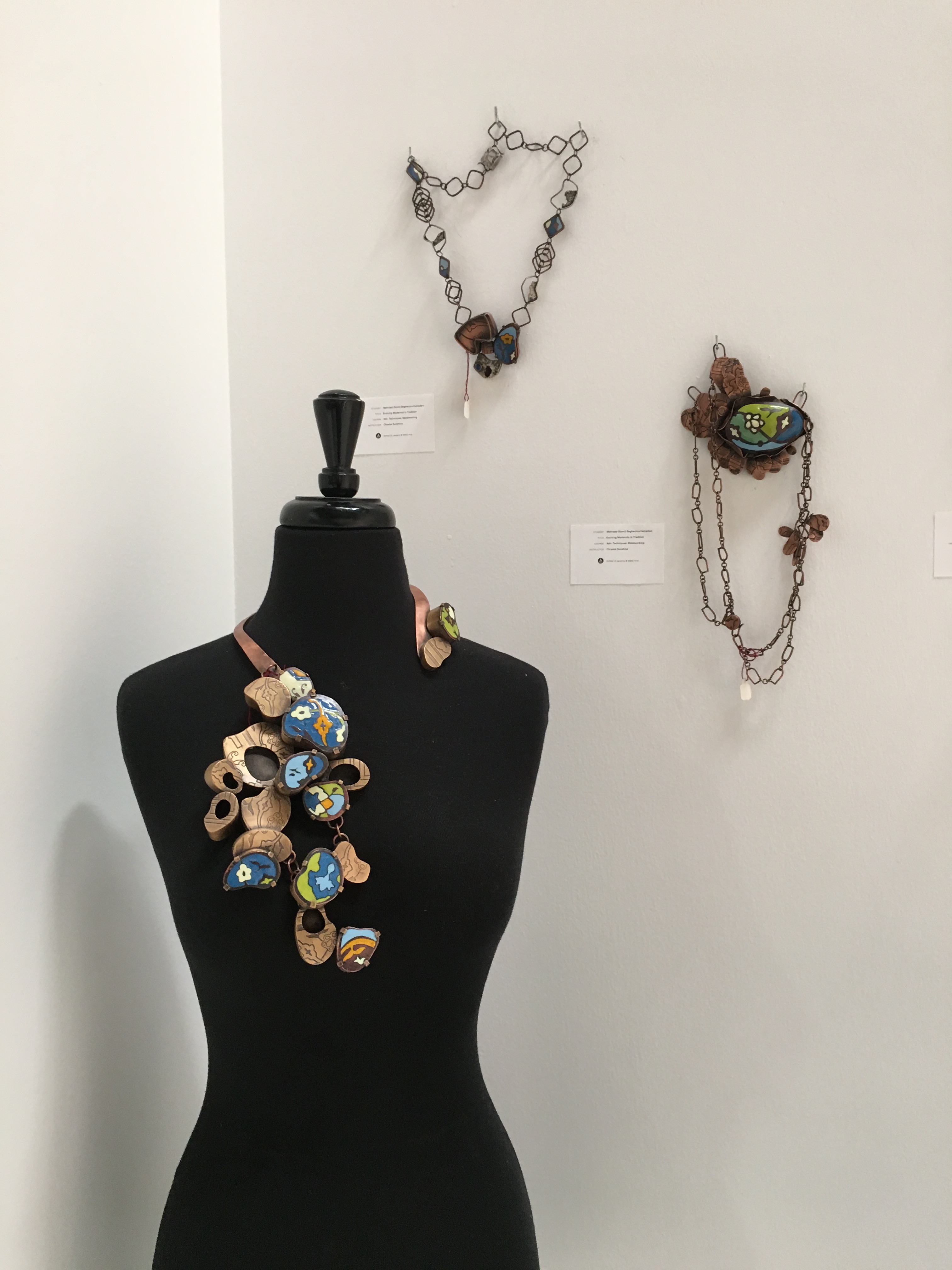
A selection of pieces by School of Jewelry & Metal Arts student Mehrdad (Nomi) Bagherpourhamedani. Photo by Cristina Schreil.
Wearable or not, this year’s JEM students proved through their work that mastering difficult processes and focusing on meticulous detail can create complex pieces, no matter what size. Whether housed securely in plexiglass boxes or sharing a wall, guests could peer up close and personal at each necklace, bracelet, crown, broach, cuff or metal sculpture. Collectively, the JEM display reflected all the various techniques taught at the school, from enameling to wax casting to forging and forming.
There were a few thesis collections laid out, including selected items from online student Julessa Barnes’ “Identity” set. The “Heart Armor” chest plate that she wore at the 2018 Society of North American Goldsmiths (SNAG) runway show in Portland Oregon hung with a choker and a few wrist ornaments.
Just a few days before, the department gave away their Spring Awards and each winning metalwork was marked with a gold sticker: Graduate student Yu “Maggie” Zhang’s metal bee and honeycomb sculpture won the Metal Arts Guild Award. Alpa Sheth’s “Perception” piece won Director’s Choice M.F.A. Award, selected by JEM Director Charlene Modena.
Sheth’s work actually took up a good portion of the JEM booth. “Her own little master’s showcase,” teased JEM instructor and tutor Francesca MacKie. Sheth had at least nine pieces or sets on display. A collectively diverse selection, Sheth’s mini-gallery showcased sculptures of curlicue brass fused to a dense, metal base to welded cups to intricate “Rings of Duality.”
“I’ve been at this school for six years. It’s been a journey,” Sheth said. “I really wouldn’t be here at Spring Show without the support of all of my instructors and classmates throughout my time here. This really feels like a dream.”
School of Landscape Architecture
The School of Landscape Architecture (LAN) brought to Spring Show an array of thesis collections and a few samplings from their various design studio classes for both the undergraduate and graduate programs. Many of the concepts—mostly marker and pencil renderings mounted on poster board—exemplified how students apply the learned analytical skills, communication techniques and spatial ideas for urban sites, private residencies, sustainable parks and land plots.
One such project was an M.F.A. thesis concept by Ritta Lei Zichun. Called the ‘Resilient Shoreline,’ the concept focused on a long-term strategy to address the environmental as well the social effects of sea level rise in the San Francisco Bay. Strategies of green infrastructure such as reconstruction, stormwater treatment and a dike system could protect and maintain the area as a public park well into the future.
Another standout concept was Yibin “Rex” Que’s winning project for the Colma Creek Resilient Park. A recent recipient of the 2019 ASLA Northern California Student Award, Que’s project also dealt with a natural system that was dedicated to preserving it by adapting it to potential flooding problems and restoring the ecosystem.
Kate Stickley, founder of Arterra Landscape Architects and a former guest at LAN Speaker Series, came by Spring Show in the evening to see the students’ renderings. Yi Su, an M.A. landscape architecture design student, got to show her concept to Stickley on the mounted TV monitor. It looked to be a public park, with an emphasis on spatial composition and organizing spaces to serve the surrounding community activities.
“I got some really great feedback from Kate. It’s always very beneficial to get insight from people outside of school, outside of my instructors,” Su said. Being a part of Spring Show meant she was among the best in her class, a token of the hard work and countless hours she and her peers put into research, drawing, rendering and deliberating over their ideas. “It’s certainly very rewarding. And we all feel accomplished and proud.”
School of Music Production & Sound Design for Visual Media
Spring Show is about sharing student work. And, at the School of Music Production & Sound Design for Visual Media, which had stations displaying B.F.A. and M.F.A. students’ projects in sound design, composition and scoring, work indeed snagged the spotlight.
Gearing up for the job hunt was also a focal point. There were tables for industry meet-and-greets. Professionals from companies like Lucasfilm spoke and offered advice.
But, as Associate Director Steve Romako emphasized, it’s also the time for his students—the only ones at the Academy not studying a visual medium—to network with peers.
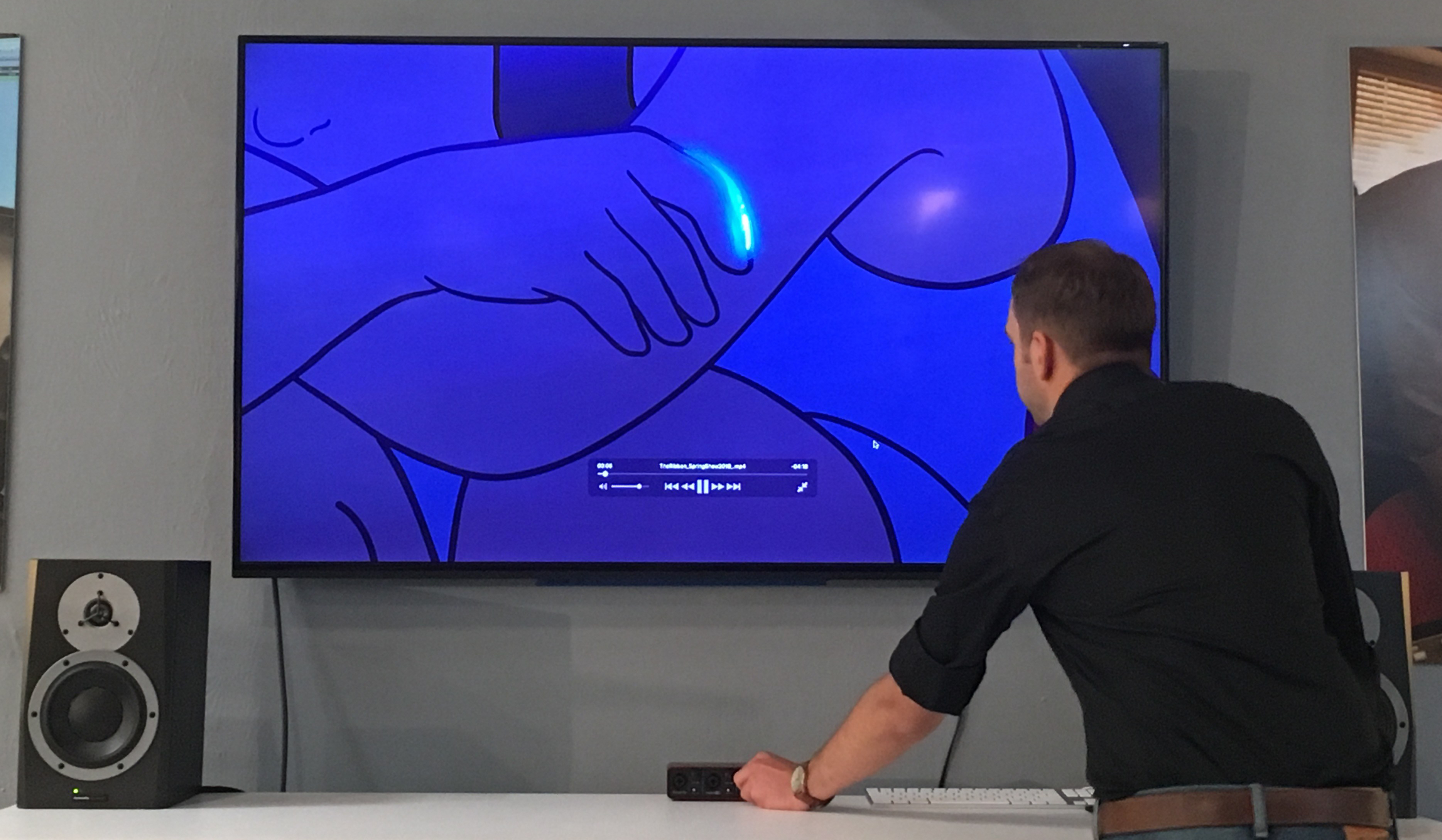
M.F.A. student Jonathan Galland cues up an animated film that he scored. Photo by Cristina Schreil.
“It’s not about them standing here, it’s about them getting everywhere,” Romako said as he gestured outward. His students supply audio for game design, motion pictures and television, animation, and even industrial design students. “We deal with every visual department,” Romako said. “It’s not just about talking to the people who are the professionals but talking to producers and game developers because those are the people who are going to hire you.” He added Spring Show mimics the hustle of post-graduation life. “Today is where they can get an idea of how to play the game.”
A large television presented the best of these cross-department collaborations. One short 2-D animated film titled “The Ribbon” featured a soundtrack by Jonathan Galland. Galland, who’s been at the Academy since 2011, is the first to graduate from both B.F.A. and M.F.A. programs. For the film, which is whimsical but dips into heartbreaking territory, Galland drew inspiration from Japanese composer Joe Hisaishi, of Studio Ghibli fame. A small string section conjured an intimate tone.
It’s a shift for Galland, who’s partial to the sweeping, epic action soundtracks that first lured him to scoring long ago. “That’s my goal in coming out of this school: something that engages the audience, makes them feel things through the power of sound,” Galland said. He added that his instructors were invaluable. “Here we have the great opportunity of having people who are currently working in the field,” he said. “You’re always up to date with what’s happening in the industry.”
School of Photography
From an inky shot of a fearsome orc to rows of vibrant eraser sushi to an elegantly dressed woman—with the head of a peacock—contrasts abounded over at the School of Photography (PH).
As PH Director Adrienne Pao expressed, it’s not just a fascinating cross-section of student work. It’s also a springboard.
“This event is very powerful. It helps students really place themselves as professionals in the industry and also get practice as to what it takes to start showing their work publicly,” Pao said.
As is standard at PH’s Spring Show presentation, 20 students presented portfolios to 13 industry professionals in 15-minute periods. Pao said this access is important—and thrilling. “Many of the students were saying ‘Thank you, thank you,’” she said. She reminded them: “It’s you. You’re doing all this!”
There were also awards.
B.F.A. student Rachelle Steele received Best in Show for her photograph of a friend and fellow Navy veteran, snapped for her Advanced Location Lighting class at Long Branch Saloon in Half Moon Bay. Steele recalled the poignant bond behind it.
“I wanted to create something really, really beautiful that was also reflective of him and what he’d gone through,” Steele said. Their intimate connection and long-established trust built since serving together enabled this exemplary shot. “He didn’t have any walls whatsoever … if you’re a good photographer that’s something you need to cultivate, but when somebody can already come at you with their walls down it’s really beautiful.”
As Steele, who graduated just days later, reflected on the program, she stressed the healing power of art. As a veteran, she said she entered with her own set of emotional issues. The program mended her “almost in an exaggerated way.” She found tools for connecting to and expressing deeper emotions. Instructor Kent Marshall cemented this. As Steele faced PTSD, Marshall “taught [her] brain a method” that helped her cope and create. “He healed pathways with his method of teaching,” Steele said.
There’s another silver lining: Just days before, Steele broke her camera. The Best in Show prize is a new one.
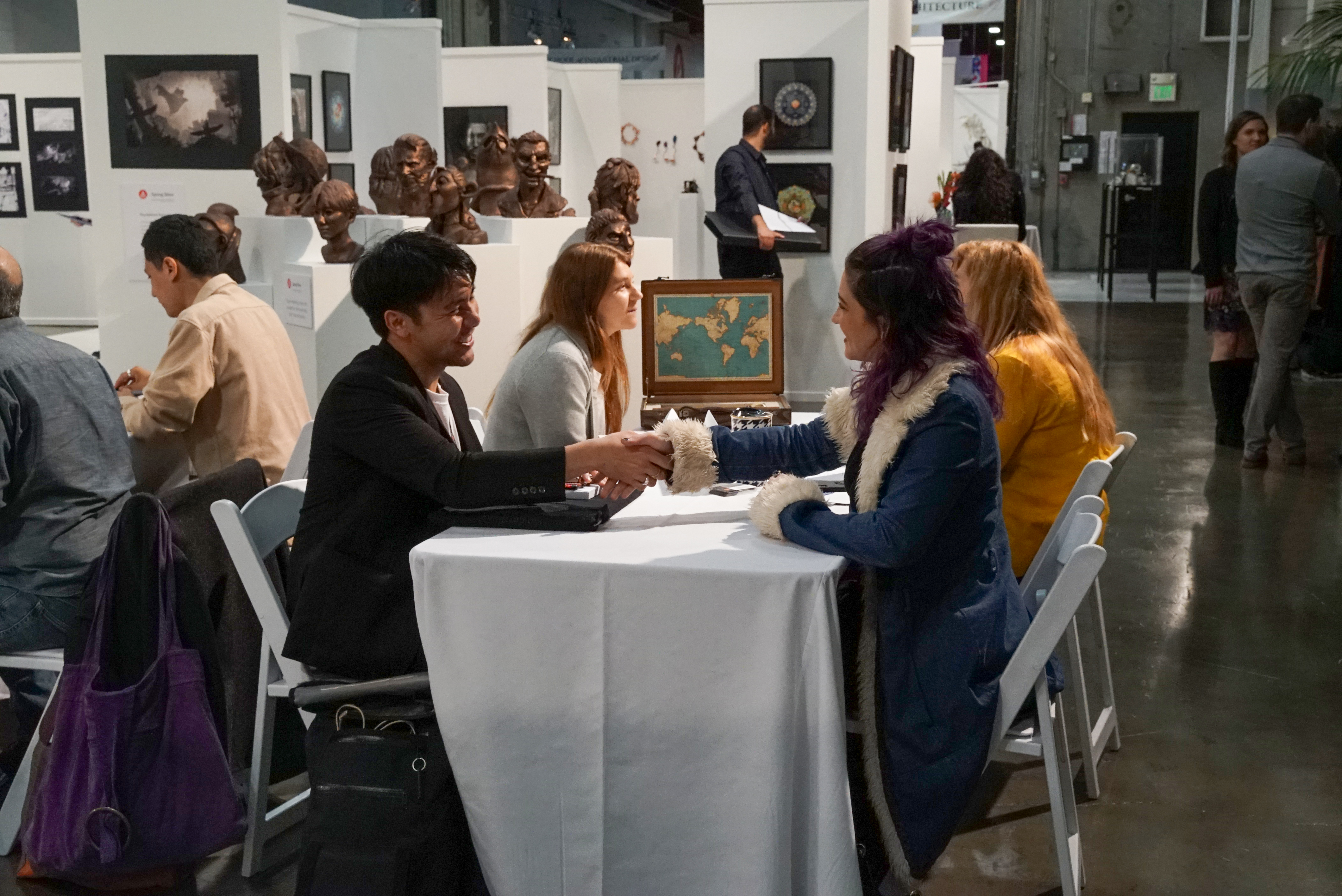
Photo by Bob Toy.
School of Visual Development
Myriad story worlds and their imaginative characters—from a sword-slinging teenaged mouse to a grotesque zombie deer to a heart-stealing demon—were on display at the School of Visual Development’s (VIS) striking Spring Show area. Art lined the walls around and behind where students set up to present portfolios. Cardboard cutouts dotted the space, but anchoring everything was a large projection cycling various examples of student work, showing the best of character design, prop design, environment design, creature design, vehicle design, live action, web and mobile games and animation.
Setting up early was Megan Dillon, an M.F.A. student set to graduate in a few days’ time. Her sights set on development for games and animation, Dillon’s portfolio conveyed her focuses on environment and prop design.
Later, she shared that the connections she made throughout the day were valuable. “One company I’ve been invited to tour and come talk with their team, one company I’ve been invited to test for, and one has contacted me about freelance opportunities,” she reported. Dillon added another bonus: seeing friends. “It was great getting the chance to catch up with them after a long semester of work.”
VIS Director Nicolás Villarreal said that this year closely followed the same process as years past—one that highlights the program’s high standards. “We look at the work and think we have something strong, and when we come to the show, it looks incredible, it looks even stronger than the year before,” he said. “I was telling the other instructors here and directors, maybe it’s only our [push towards] perfection that the work is so good that we think it gets better every year. We [hold our] standard really high.”
They’re used to industry praise—this year was no exception. “Every year they say the same. Last year, Disney came and said, ‘We would hire everyone in this row.’ And today Netflix said that too.”
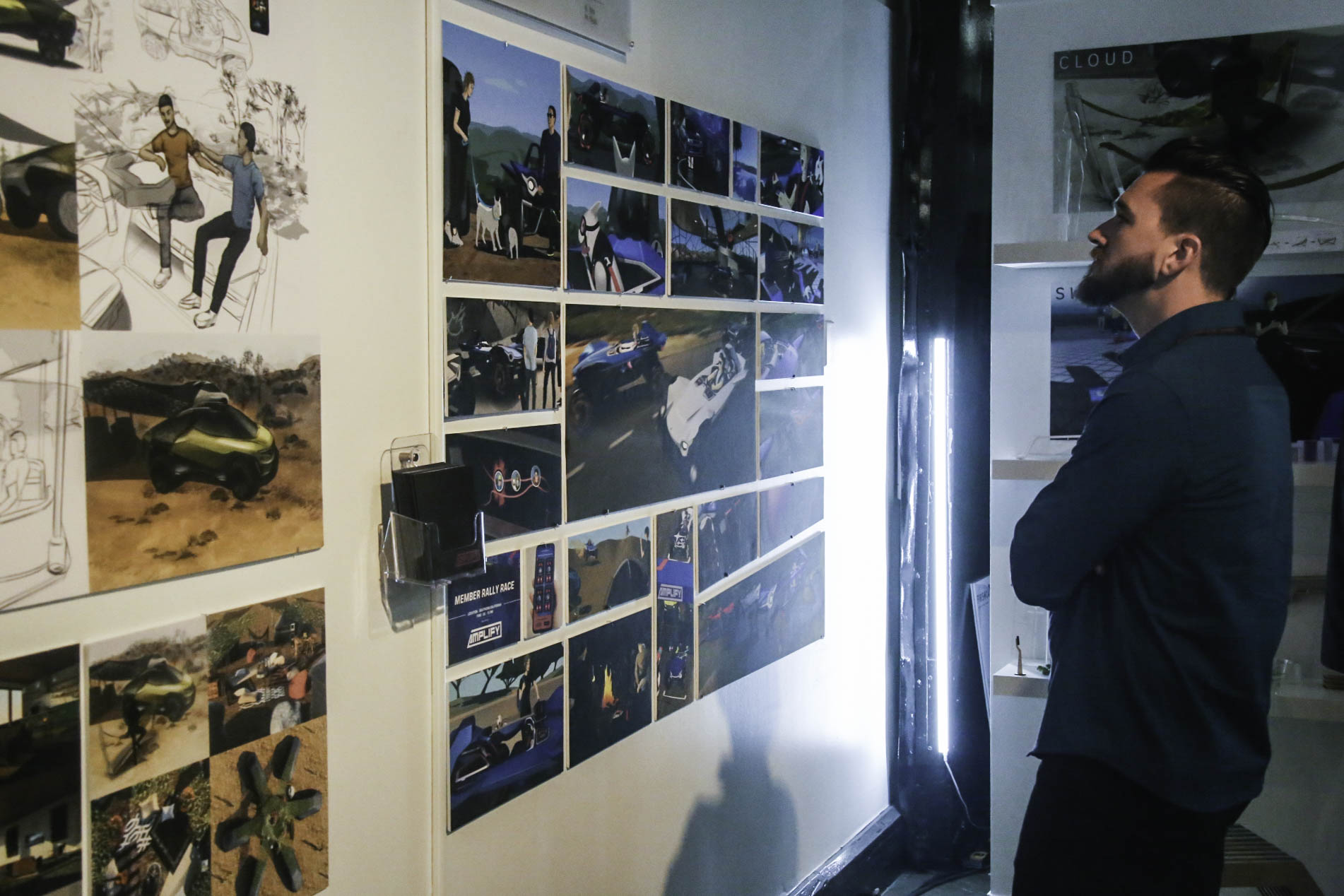
The Subaru corporate-sponsored class, led by the School of Industrial Design, also incorporated the Schools of Interior Architecture & Design, Graphic Design, and Web Design & New Media. Photo by Adrian Childress.
School of Web Design & New Media
With its networking Ideate Conference just around the corner, the School of Web Design & New Media (WNM) wanted to put its more palpable and playful projects center stage at Spring Show.
“We really wanted to highlight projects that would bring that wow factor,” said WNM Co-Director Fred McHale.
Devices from the WNM The Internet of Things class—which is defined as internet connectivity to physical devices and everyday objects—included a Zen water strobe-lit fountain, a VR climate change simulator and an interactive LED panel that danced into different shapes and shifted hues as you dragged your finger across the mousepad.
At the head of the booth, three connected monitors displayed projects from Colin Sebestyen’s Generate Art and Code class. At first, a series of dots would follow any one that stood in front of the screens, the camera inconspicuous. For a different installation, B.F.A. student Samuel Morgan and his team created an experience that procured a different color and quote from WNM instructors and students as the mouse moves across the grid. Each of these projects felt like something belonging in an Instagram museum.
“We wanted to make a piece that wasn’t too complicated and that was basically fun for people to interact with,” Morgan explained. “We did a color survey based upon the four core principles of WNM which are design thinking, user experience, visual communication and technology, and which colors were most closely associated with each category. For example, people usually associate technology with the color blue. It’s a very technical color.”
“These are the projects that are not just sort of the flashiest or the coolest-looking, but the projects that show off the principles we try to espouse as a department,” said WNM Associate Director DC Scarpelli of the “25-ish projects” featured at Spring Show. Those core principles are the backbone to how WNM students identify problems and uncover solutions that are innovative, design-oriented and user-focused. “Everything ties together to create the final experience.”
